- FORUM
- PROJECTS
- ABOUT US
- RESOURCES
- CONTACT US
- FORUM
- PROJECTS
- ABOUT US
- RESOURCES
- CONTACT US
Stone Types
India is one of the few countries in the world possessing a wide spectrum of dimensional stones viz. Granite, Marble, Sandstone, Limestone, Slate, Quartzite etc. The Indian stone industry has evolved into the following production and manufacturing categories: Dimensional stone blocks for monumental and building purposes, Processed Monuments and tomb stones, Structural slabs in all forms, Sculptures and artefacts, Calibrated modular tiles, and Cobbles, Cubes, Kerbs and Landscape garden stones.
Types of Stone
Stone is the oldest building material known to man , the origin of stone date back to a period nearly 4,000 millions years ago. Over these millions of years the continually evolving structure of earth crust has produced a wide variety of minerals outcrops. None of these deposits are identical
Igneous Stone
Igneous rocks are formed when molten rock (magma) is pushed up from beneath the earth’s crust and cools to form solid rock
The molten rock is called lava when it reaches the surface They contain crystals and are very hard.
There are two types of igneous rock Intrusive (cools within the earth)Extrusive (cools outside the earth).
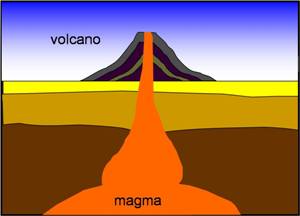
Metamorphic Stone
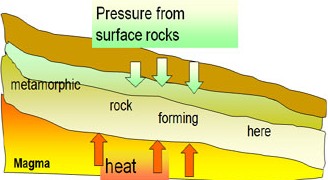
Metamorphic rocks are formed due to the effect of heat and pressure on existing rocks. Metamorphic means “changes formed” This can greatly affect the hardness, texture or layer patterns of the rocks.
This changing of one rock type into another new type takes place by an increase in temperature or pressure or a combination of both. The original minerals of the stone recrystallize, small crystals merge to form larger crystals with no changes in the mineral chemistry, fine-grained calcite in limestone recrystallizes to a coarse-grained calcite crystal structure in marble; or there may by a transformation into a different set of metamorphic minerals. This recrystallization transforms the Shale into a colorful Slate “Siliceous“. Limestone becomes a multi colored Marble “Calcareous” and the grainy Sandstone alters into a highly crystallized sparkling Quartzite “Siliceous“.
Sedimentary or igneous rock is pushed down towards the earth’s mantle. The magma heats it up and changes its structure (re-crystallization) and pressure pushes down on the rocks. The texture, mineral structure and physical properties all change. Marble and Slate are common metamorphic rocks
Sedimentary Stone
Sedimentary Rocks are rocks formed when particles of sediment build up and are “cemented together” by the effect of pressure and minerals. The rocks are weathered by Mechanical WeatheringPhysically breaks the rocks into smaller pieces Chemical WeatheringChemical reaction that break down rocks.
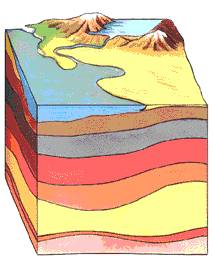

Igneous Scoria
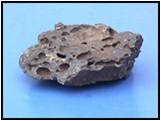
Scoria rocks are igneous rocks which were formed when lava cooled quickly above ground. You can see where little pockets of air had been. Scoria is actually a kind of glass and not a mixture of minerals.
Igneous obsidian

Obsidian rocks are igneous rocks that form when lava cools quickly above ground. Obsidian is actually glass and not a mixture of minerals. The edges of this rock are very sharp. Example are Feldspar, quartz and mica.
Igneous Pumice

Pumice rocks are igneous rocks which were formed when lava cooled quickly above ground. You can see where little pockets of air had been. This rock is so light, that many pumice rocks will actually float in water. Pumice is actually a kind of glass and not a mixture of minerals. Because this rock is so light, it is used quite often as a decorative landscape stone. Ground to a powder, it is used as an abrasive in polish compounds and in Lava soap.
Sedimentary Conglomerate
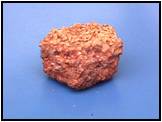
Conglomerate rocks are sedimentary rocks. They are made up of large sediments like sand and pebbles. The sediment is so large that pressure alone cannot hold the rock together; it is also cemented together with dissolved minerals.
Sedimentary Gypsum

Gypsum are sedimentary rocks made up of sulphate mineral and formed as the result of evaporating sea water in massive prehistoric basins. It is very soft and is used to make Plaster of Paris, casts, molds, and wallboards.
Sedimentary Limestone

Limestone are sedimentary stones that are made from the mineral calcite which came from the beds of evaporated seas and lakes and from sea animal shells. This rock is used in concrete and is an excellent building stone for humid regions.
Sedimentary Sandstone

Sandstone are sedimentary stones made from small grains of the minerals quartz and feldspar. They often form in layers as seen in this picture. They are often used as building stones.
Sedimentary Shale Stone
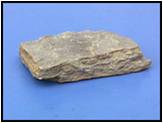
Shale Stone is a type of sedimentary rock formed from clay that is compacted together by pressure. They are used to make bricks and other material that is fired in a kiln.
Metamorphic Gneiss
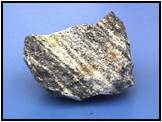
Gneiss rocks are metamorphic. These rocks may have been granite, which is an igneous rock, but heat and pressure changed it. You can see how the mineral grains in the rock were flattened through tremendous heat and pressure and are arranged in alternating patterns.
Metamorphic Schist
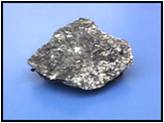
Schist rocks are metamorphic. These rocks can be formed from basalt, an igneous rock; shale, a sedimentary rock; or slate, a metamorphic rock. Through tremendous heat and pressure, these rocks were transformed into this new kind of rock.
Granite Stone

Granite basically refers to a common, coarse-grained, light-colored, hard igneous rock comprising chiefly of quartz, orthoclase or microcline, and mica, used widely in monuments and buildings. It is a common and widely-occurring type of intrusive, felsic, igneous rock that form at great depths and pressures under continents. Ordinary granite always carries a small amount of plagioclase, but when this is absent the rock is referred to as alkali granite. Granite consists of orthoclase and plagioclase feldspars, quartz, hornblende, biotite, muscovite and minor accessory minerals such as magnetite, garnet, zircon and apatite. Information on this site is purely for education (students / users) purpose. The materials used and displayed on the Sites, including text, photographs, graphics, illustrations and artwork, video, music and sound, and names, logos, IS Codes, are copyrighted items of respective owners. They are provided here just for refrence/information.
Forum Threads
For your views and discussions Register in FDAchitects Forum …